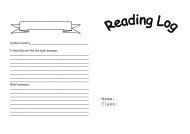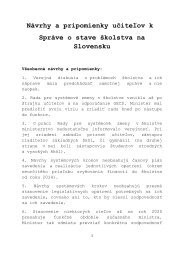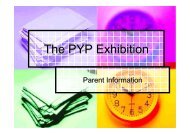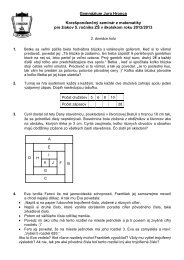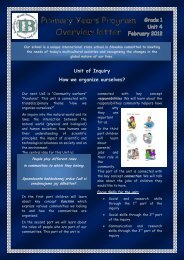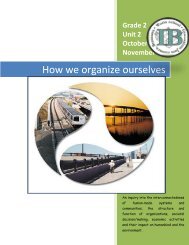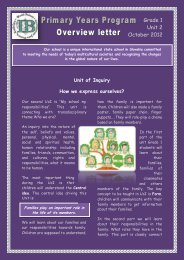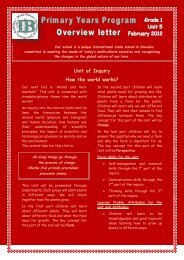Documentation Magic Squares
Documentation Magic Squares
Documentation Magic Squares
- No tags were found...
Create successful ePaper yourself
Turn your PDF publications into a flip-book with our unique Google optimized e-Paper software.
<strong>Documentation</strong><strong>Magic</strong> <strong>Squares</strong>Author: Matej HamašClass: III. IBD-ATime of elaboration: June 2011This game has been tested by two classes of pupils. The first classwas 3 rd class, which tested the game on 10.6.2011 and the secondone was PYP 2 class, which tested this application on 13.6.2011.What were the reactions of pupils to the gameIn general the reactions of pupils have been more positive thannegative. They showed the happiness when they successfullysolved a square. However, when I compare my game to someother, less logically demanding, applications, I think that thisgame has been less popular. The main reason is probably that thisgame tests mainly the mathematic skills of pupils. I have askedseveral children whether they like mathematics and in most timesI have got the answer that the mathematics is not the worstsubject, but it cannot be said they would really like it. This showsthat the interest in logical thinking is probably not very spreadamong young children. It is just my opinion, as I conclude it also from my observations of today’ssituation in the education system and from things I hear in everyday live. I do not dare to generalize,since the sample of pupils was very small, but I feel it like this.Were there any major differences between two tested classesI would say the differences were clearly visible. The pupils of the first class were older, they had beenlearning mathematics for three years, and I can definitely say, they had fewer problems solving themagic squares. They also showed more interest in the application. The pupils from PYP 2 class were
younger, their interest was lower and they had also more problems with doing simple mathematicoperations.How the rate of successfulness varied between different square sizes anddifficulty levelsThere were no greater difficulties with solving 3x3squares at the easy level. This task was in majority ofall cases successfully solved by almost all pupils. In thecases of 3x3 squares at medium difficulty and 4x4squares at easy difficulty, pupils were also able tosolve these squares. Obviously, problems in such casesoccurred, mainly for PYP 2 pupils. The majority ofchildren did not dare to try harder levels, as they found the actual less difficult levels challengingenough (quote: “To sa mi zdá byť dosť ťažké.”). Only one or two children tried solving the magicsquare of 5x5 size or at hard difficulty level. This shows that this application is suitable also for olderchildren. I think older children would appreciate harder levels as well, while for young ones the easylevels were difficult enough.The main problems, children had to overcomeOf course, all problems, involved in this topic are of mathematic nature. Despite the fact children inmost cases did not have problems with doing sum operations; they found it more difficult to dominus operations. Some problems occurred also when a child was forced to do sum operation on theedge of 10 (e.g. 7+5), or during calculating higher, or more numbers. Children used few tricks, how tomake the calculating easier. Some of them were telling the numbers and sums loudly. I have evenmet the child, who still helped himself by counting on fingers.The situation was improving as children spentmore time solving the square. During solving timeof their 2 nd , respectively further square, theircalculations were more correct and they madefewer mistakes. It was probably because they gotinto the right mood of doing mathematics, theyengrossed themselves in the counting and afterlonger time, they were able to concentrate moreon the given task. When I offered them pen andpaper, it helped them a lot, mainly for solving more difficult operation with higher numbers.
The technical point of view1. Things that could be improvedThe first improvement, I would do in this application is the following one. Children obviously do notknow what sum should be in every row. This sum can be easily calculated, by the sum of arithmeticsequence of n numbers, with the difference one. The equation for square of size n*n would look likethis:∑ ( ) ( ). It means this sum is15 for 3x3 squares, 34 for 4x4 squares and 65 for 5x5 squares. When children were solving thesquares, I had to tell them every time the correct sum. It would help a lot, if this sum was showed onthe screen, e.g. in a simple JLabel.I think, the following feature could be implemented and it would improve the game experience.There should be an option, which allows children to let computer to solve just one cell. This wouldhelp lots of children. The number of such option would be restricted e.g. to three, and every timechild chooses it, he would gain some minus points (or the solving time would increase by +1 min.).2. Things which were not necessaryThe first unnecessary thing was the implemented KeyListener. 100 % of tested children did not usethe keyboard and preferred to solve the square using the mouse. This shows that young children arenot used to keyboard so much. It means I could have saved a lot of time, if I had not implementedthis possibility. However, the advantage of this is that since this game is aimed also at older children,these may show the interest in using keyboard instead of mouse.All children testing this application were Slovak, or at least preferred Slovak language (even PYPs).Therefore the possibility to choose the language was useless. However, this implemented languagechoice may be useful, so I do not regret implementing this feature to the game.Also the long, difficult, random-based method (described in the document What I have learnt) forsolving the magic square was not extensively used. Only 1 child tried this square solver. Since thisfeature was not necessary for the running of the game, and I even had not planned to implement itto the code, I am not surprised. This just shows that young children do not need the solver for goodgame experience. When they do not know how to solve the square, they are in the majority of casesnot interested about the correct answers.



